Back at The Parsonage
As the seasons roll by, it’s time to start another Design Course at The Parsonage in Didsbury. With the sensation of constant change in the air, it’s good to take the short stroll down the hill into the Mersey floodplain, get the new group oriented in the landscape, and enjoy the more timeless qualities that exist where “historic” neighbourhoods give way to open country and Nature herself. (We learn to discount the distant rush of the M60 and the airport beyond.)
It is already clear that we have yet another group of talented people who can already contribute much to the study of design and the challenges of moving through “modernity” towards “futures”. We made a good start with systems thinking and energy planning, and future course days give us something to look forward to as the winter closes in.
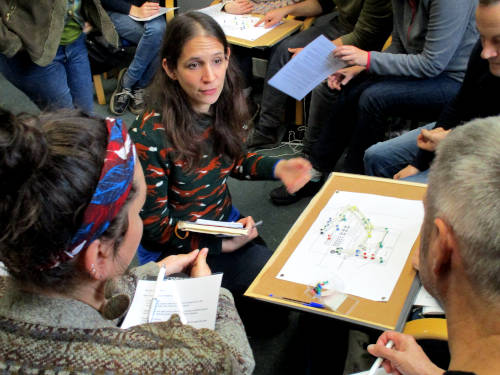 |
 |
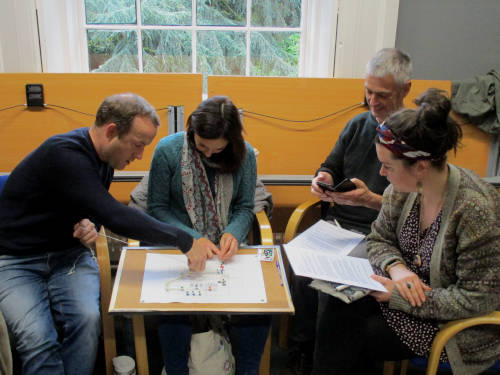 |
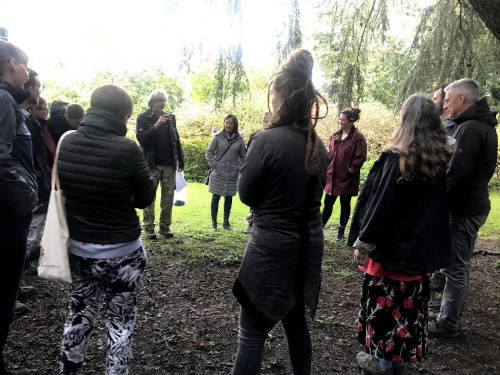 |
 |
 |
“Open House” at Manchester Road
This season’s Northern School social event took place at Manchester Road Community Centre, a re-purposed former primary school. The social turned out to be a family affair with children much in evidence (and very well behaved, too!)
These quarterly events are mainly about meeting up with friends old and new (and, at Manchester Road, having a great shared meal round the table in the big hall). We are interested in each other’s projects and there’s always time for people to share progress, with a little stall or a presentation. This time, we enjoyed an excellent talk from Saynab Shire about the design of her garden, which led to the usual creative discussions.
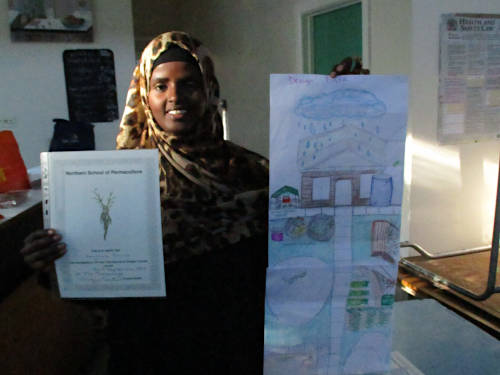 |
|---|
 |
Peter Fearon arrived from Liverpool bringing us an update from Quinta da Estralinha, his property in Northern Portugal. He hopes to move there permanently next year with his family. Again his design work stimulated much discussion and was a great “showcase” for those who were not familiar with our work as permaculture designers.
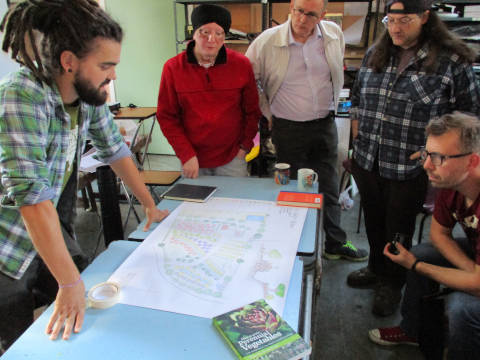 |
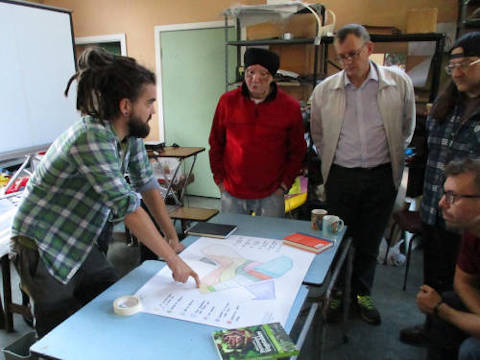 |
 |
 |
Jas Singh gave an impromptu talk on “The Solar Farm” and we discussed appropriate sites, including the use of low-lying land in West Lancashire, for example near Burscough Community Farm.
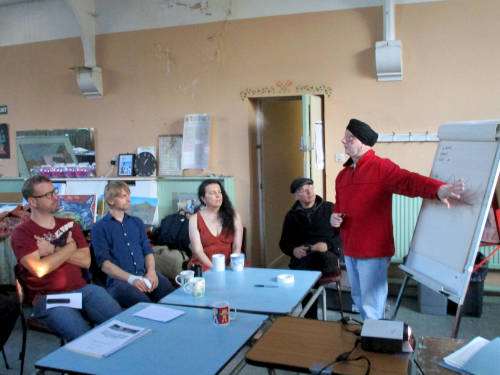 |
|---|
 |
All this has left us reflecting on the need in our Northern School program for some “pop up” meetings for designers and project leaders, where we can swap ideas and gain some mutual support. Our graduates are telling us that they miss this once their PDC has finished. Watch this space, or better still, host a meeting for us.
Lancaster ESTA
Ethical Small Traders Association in Lancaster
Angus has been supporting Michael Hallam with the growth of the ESTA network. The Northern School is an ESTA member and our responsibility is to help where we can. Members commit to Michael’s idea of a “fourth bottom line” for small traders, whereby one of the yields of the business is to support the personal development of the founders.
The network now has around 150 members and there are potential offshoots in other cities. Growth has been organic and steady, but the time has come to to develop a more distinct profile and to prepare for an increase in services to members.
We attended a recent event in Lancaster where Michael teamed up with Sarah Ludford to deliver a workshop on “managing conflict”. We were a diverse group and we had a chance to share experiences with participants working in larger organisations such as Universities and the NHS. By the end of the day, those of us who were “running our own show” realised that managing conflict is far easier in our working environment and we went away feeling quite privileged compared to our colleagues in the larger organisations. Angus said he was determined to write something about the differences in corporate life between the 1970’s and today. But we’ll have to see if he finds the time!
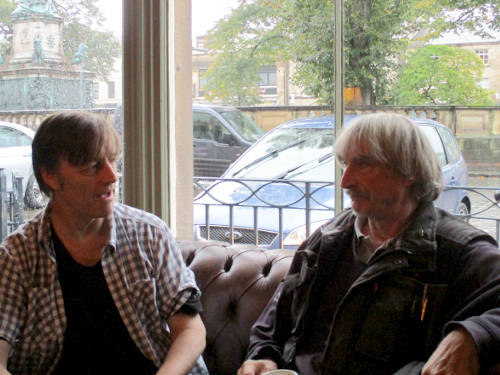 |
|---|
| Angus and Michael Hallam at The Borough in Lancaster |
 |
RHS Bridgewater
Report by Angus Soutar
This September we took the opportunity to go on a “pre-opening tour” of the new gardens at RHS Bridgewater, at Worsley, just outside Salford. RHS (Royal Horticultural Society) are creating “the biggest gardening project in Europe”, due to open in summer 2020. The tour gave us a chance to see the work in progress and review the design proposals for this fascinating site.
The site consists of 62 hectares of largely open country, just outside the built-up area of Salford. It has a fascinating history that spans the Industrial era. In 1748, Francis Edgerton, the third Duke of Bridgewater, inherited estates at Worsley. He found it 'a God-forgotten place; its inhabitants were much addicted to drink and rude sports, their morals being deplorably low. The whole district was in a state of religious and educational destitution; there was no one to see to the spiritual wants of the people, and teaching was all but nullity itself.'
Nevertheless, he felt obliged to live there and set about improving the area, building churches and schools. He had the advantage of highly productive coal workings in Worsely and devoted much of his life to the construction of the Bridgewater Canal, one of the first “proper” canals of the Industrial Revolution, to take the coal through to Manchester and then on to Runcorn. Contemporary accounts name him as the richest nobleman in England. He built Worsley (Old) Hall on a site near the town and created extensive kitchen gardens, parkland and woodlands.
On the death of the third Duke, his heirs, at great expense, built Worsley New Hall (1845) and constructed huge Versailles-style formal gardens, landscaping the parkland to include a large ornamental lake.
 |
|---|
| Worsley Hall Lake, then ... |
 |
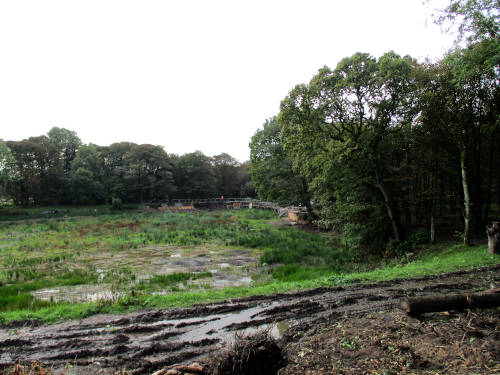 |
|---|
| Worsley Hall Lake, September 2019 |
 |
Nothing much of this remains. The Old Hall and New Hall are long gone, with the New Hall being largely abandoned after the First World War. The mines have closed. Much of the park has reverted to Nature, and the park contains many fine mature trees, although rhododendrons have been continuing their relentless invasion. The ethno-archeaology of the woods shows fascinating traces of the occupation of scout troops in recent years. There can be no finer location for young Salfordians to enjoy the outdoors and learn more about Nature. Unfortunately, they too have been evicted. At the time of our visit, the once-peaceful park had been turned into a huge construction project. The arrival of the new gardens will not be powered by coal, but by diesel.
Our guide explained how, back in the Age of Coal, the house would function with the work of a company of servants, mainly young women, and the gardens would be tended by a small army of working-men. Coal would not only keep the house warm, it would also provide for the extensive glass hot-houses to produce, in the extreme, tropical fruit like bananas and pineapples. The stables are some of the few surviving structures from those times. It would be good to develop the “gardener-serving maid” tour narrative to include the working horses and ponies. We could easily picture them throughout the park, pulling all manner of traps and carts as well as the fine carriages of the day,
More importantly, the massive (11 acre) Victorian walled garden has survived and is already playing a key part in the renovations.
 |
|
 |
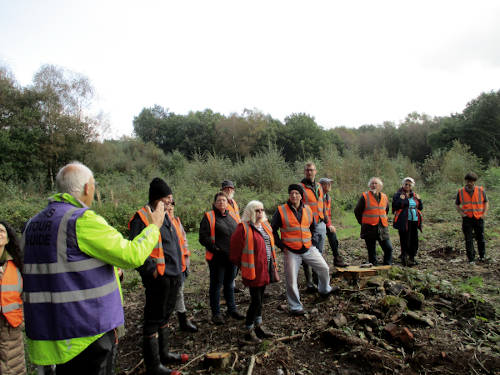 |
 |
 |
The design for the £31M project includes a state-of-the-art eco-building, the “Welcome Building”, which will dominate the southern part part of the site, together with an acre or two of car park and access roads. There are some interesting designs introduced across the site, for example, the Welcome Garden has a tessellated pathway that aims to distribute pedestrian flow at one of the predicted bottlenecks near the Welcome Building. We saw creative use of animals on the site with a highly effective herd of pigs hard at work on ground clearance.
On the other hand, our tour guide, although friendly and knowledgeable, could give us little insight into the design philosophy for the whole 153 acres of the site. In particular, the original kitchen gardens (well-aspected but now reverted to woodland) were inaccessible for reasons of time and “safety” . They are, in any case, not a priority for re-development. This contrasts to the Manchester Permaculture trip last year to the Phillips Estate (Phillips Park, Prestwich) which lies only a few miles away along the M60 where restoration work on the kitchen gardens is led by local volunteers. Both sites, in their own way, embrace “horticulture”, but from a permaculture perspective we are more interested in getting the best out of a site re-design, especially where food production and carbon capture are concerned.
It was difficult for us to reconcile the 21st century proposals for the Centre with those for other areas of the site, with their Chelsea-style “themes” plucked from local “heritage” (Queen Victoria plants a giant sequoia) and diverse “community cultchas” (don’t ask). We came to the reluctant decision that the dominant design concept for this wonderful park is turning out to be: “build a giant Garden Centre near the Motorway”.
Thanks to Jas Singh for organising the event and also to Royston, our highly knowledgeable tour guide, who donates his time to RHS to keep visitors well-informed about this fascinating project.
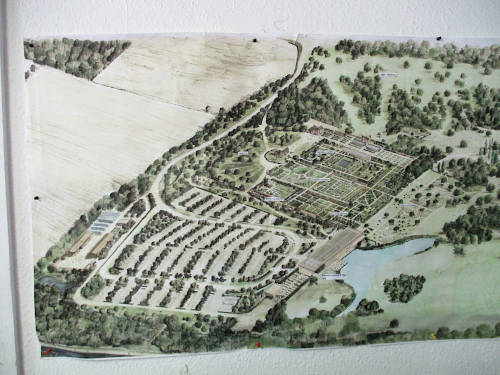 |
|---|
| Site design - Victorian style |
 |